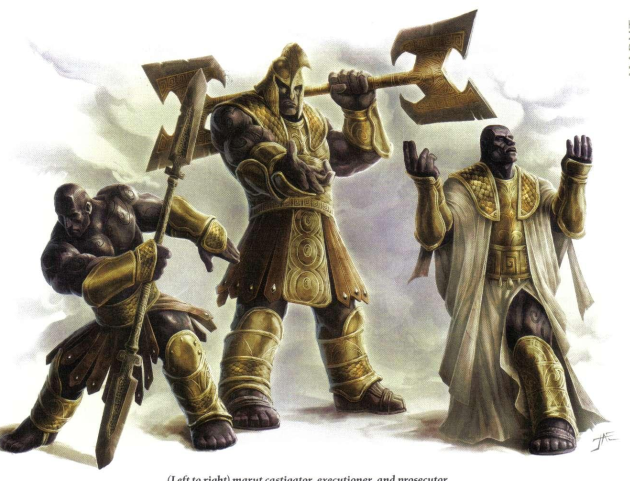Let's Read the 4e Monster Manual 2: Marut

Fourth edition Maruts debuted in the first Monster Manual, as enigmatic mercenaries from the Astral Sea that demanded future favors as payment for their services and kept detailed ledgers of these in their astral fortresses. Here we get a bit more lore about them, and three new stat blocks to go with the two from the first MM.
The Lore
The MM2 bits of lore seem to have been written by a different author from the first, and this second author seems to have time-traveled from 3e or 2e. It talks a lot about Maruts being interested in “the upholding of oaths and contracts” in the abstract, which doesn’t really match the first book. Yes, they’re very interested in this stuff, but only when the oaths made by them or to them.
There’s also another bit that says they consider themselves to be “astral spirits of the air”, and despite the convoluted justification accompanying this I don’t think the Astral Sea is a place with strong elemental associations either way.
A more interesting bit is the one that says Maruts aren’t an unified block - they’re divided into groups called “cadres” that hold slighty different philosophies. Each cadre has their own fortress and interacts with other sapients in more or less the same way, but I guess they differ in what they’re stockpiling those favors for.
Some cadres have started calling in a few of their favors and demanding periods of indentured servitude from people. Maruts don’t mistreat their servants, but they’re still demanding and humorless bosses.
The Numbers
The Maruts in this entry are Medium Immortal Humanoids. They have Truesight out to 10 squares, a ground speed of 8, and flight and teleport speeds of 4. They’re immune to sleep and have Resist Thunder 10.
All of the stat blocks in this entry are described as “hunting down those who oppose marut law”, which again doesn’t quite make sense. Pretty much every Marut will hunt and fight someone who backed out of a deal with them, so instead of repeating this I’ll speculate about what someone might hire these new varieties for.
Marut Castigator
Castigators make good bounty hunters, since they’re good at preventing their target from running away. They’re Level 21 Skirmishers with 146 HP and all standard traits. They wield a double sword in combat, and have access to thunder and lightning-themed magic.
Their basic double sword attack can deal physical or lightning damage, at the marut’s discretion. They can also make Double Attacks with it, but not all the time (recharge 4+).
To prevent someone from running, they can use the Punisher’s Lash, a Reach 2 vs. Reflex spell that deals weak lightning damage, slows, and prevents the target from teleporting for a turn. If the target still tries to run, they can give chase with a Thunderbolt Strike, which allows them to teleport 4 squares and make a basic attack with bonus damage afterwards. This recharges when they hit with the two strikes from a double attack.
Marut Prosecutor
Objection! Prosecutors are probably pretty good at that very role during an actual trial, with their epic levels of Insight and Intimidate. They can also use magic to infuse their words with the leaden weight of the law.
Prosecutors are Level 21 Controllers with the Leader keyword and 147 HP. They can punch people with slams that do bonus thunder damage and slow (save ends), but their judicial magic is their greatest asset.
As a minor action they can issue a Dictum (Ranged 10 vs. Fortitude) that does no damage and immobilizes (save ends). They can also use a minor action to mark someone with a Sigil of Indictment (ranged 10 vs. Will), which also does no damage but forces the marked victim to grant combat advantage to the prosecutor and take 5 extra psychic damage from all attacks directed at it. This lasts for a turn and can be sustained, but only one target can bear the Sigil at a time.
Finally, the prosecutor can take a bit more time and spend a standard action to harangue someone with a Biting Testimony (close burst 10, targets one enemy, vs. Will). This deals psychic damage, and inflicts a -2 penalty on all of the target’s attacks, skill checks, and ability checks (save ends).
All of this means prosecutors call the shots during a fight, marking someone with the Sigil and having their allies focus fire on the victim, which they’ll try to immobilize with Dictums. Dictums can also be used to prevent defenders from helping a focused squishy. “Close Burst X; targets one enemy” is just a terse way of saying that power is a ranged attack that doesn’t draw OAs.
Marut Executioner
An executioner is who you call when you need an obstacle removed. When they’re not doing that, they’re out collecting debts owed to their cadre.
Executioners are Level 22 Brutes with 205 HP. They wield Double Axes that does bonus thunder damage, knocks prone on a critical, and can be used in several other maneuvers. Slayer’s Fury (encounter) allows them to attack everyone in a Close Burst 1; Warranted Stroke targets a bloodied enemy, does a ton of damage, always knocks prone, and gives the executioner 1 action point if it drops the target to 0 HP or less.
They can also issue an Execution Call once per encounter, a Close Blast 5 that targets enemies’ Fortitude, does thunder damage, and pulls them adjacent to the executioner. A miss here still does half damage.
Sample Encounters and Final Impressions
I like the mechanics of these new Maruts, but I dislike the throwback to 3e lore here. Law is not a universal cosmic principle in 4e!
The sample encounters have marut mercenary squads accompanying a djinn (level 21) or a trio of rakshasa knights (level 23).